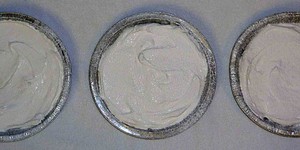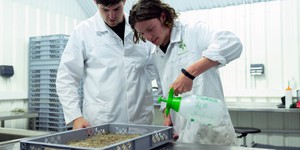Summary
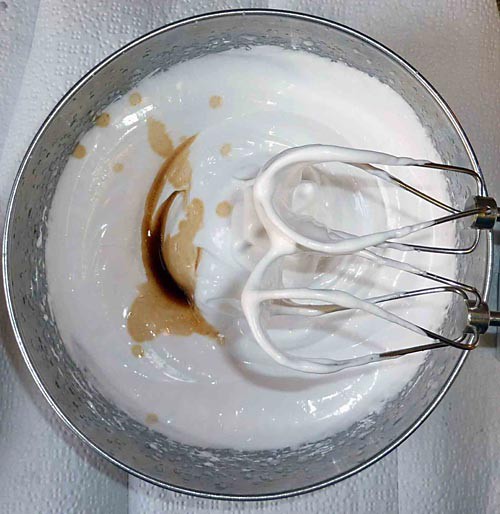
Introduction
Whether you are huddled around a fireplace, or drinking hot chocolate after a day in the snow, nothing says fun quite like a marshmallow! Even its name is soft and spongy! Have you ever wondered how marshmallows are made? Long ago marshmallows were actually made from a plant, the marshmallow plant, but today we usually make them using a few key ingredients, namely gelatin, corn syrup, and sugar. In this appetizing activity you will get to explore what ratio of sugar to corn syrup produces the best-tasting and best-textured marshmallows!Materials
- Masking tape
- Pen or marker
- Ruler
- Paper towels
- Timer
- 8 or 9 inch square foil cake pans or round foil pie pans (2)
- Small sifter or strainer
- Large mixing bowl
- Small saucepan with lid
- Electric mixer or beater
- Measuring spoons
- Measuring cups
- Fork
- Spatula
- Pizza wheel or cookie cutter approximately 1 inch by 1 inch
- Large air-tight containers or gallon-size sealable plastic bags
- Water
- Vegetable oil, like canola or safflower oil
- Corn syrup, light or dark is fine (1/2 cup)
- Powdered or confectioner's sugar
- Plain, unflavored, ¼-ounce gelatin envelopes (2); available at grocery stores
- Granulated sugar (1 ¼ cups)
- Candy thermometer; it must be able to read up to 240 degrees Fahrenheit, or about 115 degrees Celsius
- Vanilla extract
- Taste-testing volunteers, such as friends and family!
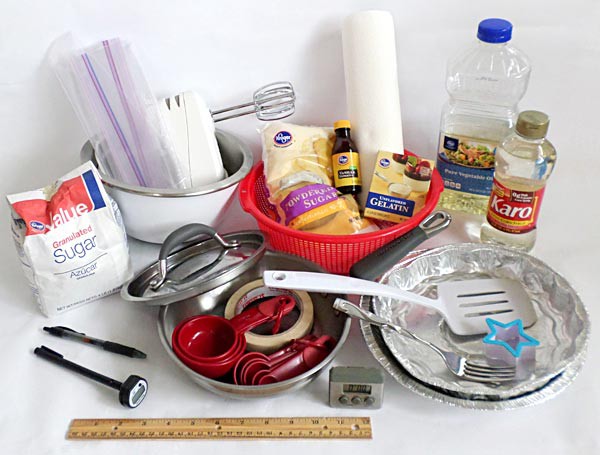 Image Credit: Teisha Rowland, Science Buddies / Science Buddies
Image Credit: Teisha Rowland, Science Buddies / Science Buddies
Instructions
- Use the masking tape and a pen or marker to label the bottom of one cake pan "#1" and the bottom of the other cake pan "#2."
- To prevent the done marshmallow from sticking to the pans, pour a small amount of vegetable oil on a paper towel and lightly oil the inside of the cake pans. Pour a small amount of powdered sugar in the sifter and lightly dust the inside of the cake pans.
- Pour 1/6 cup (C) of cold water into the large mixing bowl. (To get 1/6 C, just fill up the 1/3 measuring cup halfway.) Sprinkle one ¼-ounce packet of gelatin over the cold water. Mix the gelatin and water together for about 5 seconds with a fork and set the bowl aside. This will give the gelatin time to "soften" or "bloom."
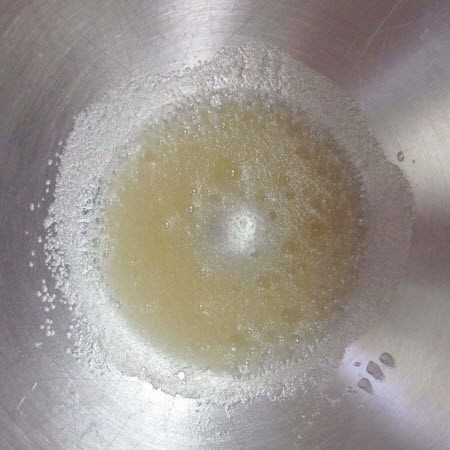 Image Credit: Summer testing / Science Buddies
Image Credit: Summer testing / Science Buddies
- Add ¼ C cold water, ½ C sugar, and 1/3 C corn syrup to the saucepan. (This is a 3:2 ratio of sugar:corn syrup.)
- Put the lid on the saucepan and turn the stove to medium-high heat. An adult should closely supervise all work from this point on. The syrup solution, which will become very hot, should be handled with extreme care.
- Lift the lid and check the solution in the saucepan about every 30 seconds until it just comes to a boil. Remove the lid.
- Begin to measure the temperature of the syrup in the saucepan using the candy thermometer. Do not let the thermometer touch the bottom or side of the pan, but instead try to put the tip below the surface, near the middle of the pan. Continue heating your syrup until the temperature reaches 240 degrees Fahrenheit (about 115 degrees Celsius). How does the temperature rise? Does it go up quickly at first? What happens as the syrup becomes more concentrated?
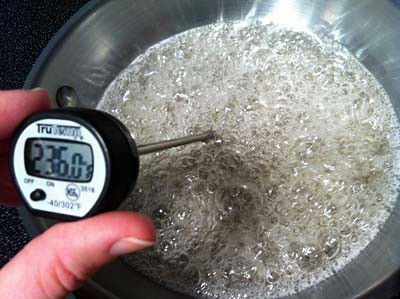 Image Credit: Teisha Rowland, Science Buddies / Science Buddies
Image Credit: Teisha Rowland, Science Buddies / Science Buddies
- When the temperature reaches 240 degrees Fahrenheit (about 115 degrees Celsius), immediately turn off the stove and move to the next step.How does the syrup mixture seem to have changed as it gets closer to this temperature?
- Turn the mixer on low and carefully pour the hot syrup into the large mixing bowl with the gelatin. (Some syrup will likely solidify on the saucepan.) Set the timer for 11 minutes and start it.
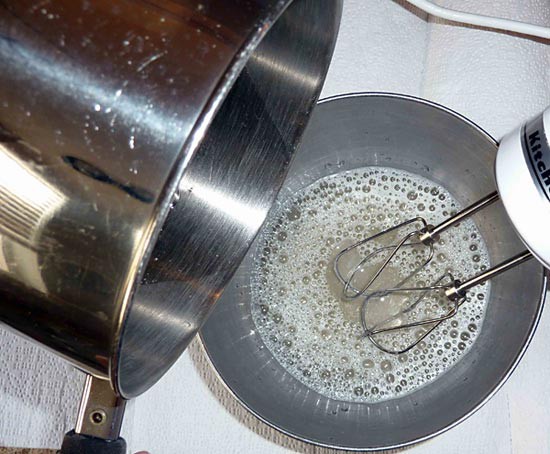 Image Credit: Kristin Strong, Science Buddies / Science Buddies
Image Credit: Kristin Strong, Science Buddies / Science Buddies
- Gradually increase the speed of the mixer until it is operating at full (high) speed. Continue to beat for approximately 11 minutes, or until the mixture starts to become very thick, glossy, and lukewarm. How does the mixture change as you mix it?
- Add ½ teaspoon of vanilla and then beat for one more minute. Note how long you beat the syrup.
 Image Credit: Kristin Strong, Science Buddies / Science Buddies
Image Credit: Kristin Strong, Science Buddies / Science Buddies
- Quickly use a vegetable oil-coated spatula to scoop out the marshmallow mixture from the mixing bowl and put it into the prepared cake pan labeled #1. If needed and easy to do, use the spatula to gently smooth down the top of the marshmallow so that it is pretty flat.
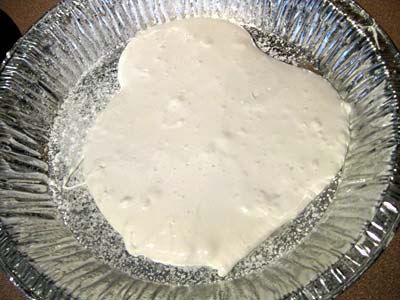 Image Credit: Teisha Rowland, Science Buddies / Science Buddies
Image Credit: Teisha Rowland, Science Buddies / Science Buddies
- Wash and dry all cooking utensils.
- Repeat the entire activity procedure (except for the first two steps) but this time add ¾ cup sugar and 1/6 cup corn syrup to the saucepan. (This is a 9:2 ratio of sugar:corn syrup.) (Still add the ¼ cup of cold water to the saucepan first.) In the mixing bowl, beat this recipe for the same amount of time. When it is ready, scoop this marshmallow mixture from the mixing bowl and into the prepared cake pan labeled #2.
- Allow the marshmallow "pies" to sit out, uncovered, on a counter for at least four hours, or up to overnight, so that they can become firm. Once firm, turn the marshmallow pies over, one at a time, onto a cutting board. Use a spatula to help lift the pies out.
- Roll a pizza cutter or cookie cutter into some powdered sugar and then use it to cut up your marshmallows into approximately 1 inch by 1 inch pieces. Dust the marshmallows on all sides with a little sifted powdered sugar.
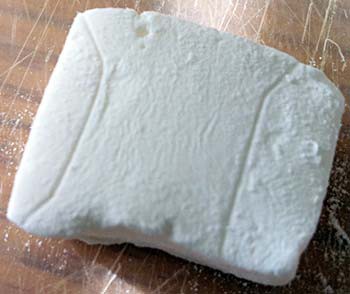 Image Credit: Teisha Rowland, Science Buddies / Science Buddies
Image Credit: Teisha Rowland, Science Buddies / Science Buddies
- Place the marshmallows in an air-tight container or plastic bag, labeling the container with the number of the recipe (#1 or #2).
- Within a week of making the marshmallows, take a marshmallow piece from each bag. Try to find pieces that are as similar in shape and size as possible. Drop each marshmallow in a saucepan of hot water, keeping track of which marshmallow was from each recipe. Watch and see how quickly each marshmallow piece melts. Repeat this melting test three times.Which marshmallow piece melted first?
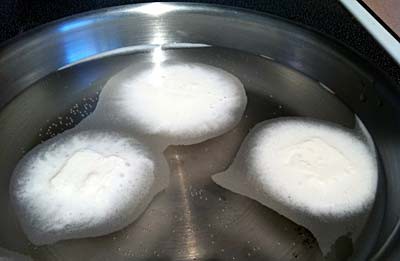 Image Credit: Teisha Rowland, Science Buddies / Science Buddies
Image Credit: Teisha Rowland, Science Buddies / Science Buddies
- Within a week of making the marshmallows, gather your taste-testing volunteers (such as family and friends!) to evaluate the marshmallows for taste and texture.Which marshmallows do they prefer? Which ones are the chewiest, and which ones are the least chewy? Which are the softest and which are the hardest?
Cleanup
What Happened?
The greater the concentration of sugar in a solution, the higher its boiling point. So, although pure water boils at 100 degrees Celsius the ingredients to make marshmallows (water plus corn syrup and sugar) boil at a higher temperature —closer to 115 degrees Celsius. Similarly, marshmallow pieces from recipe #1, which has less sugar, should have had a lower boiling point than pieces from recipe #2, making pieces from recipe #1 melt faster than pieces from recipe #2 when placed in hot water. The final concentration of sugar in the syrup affects the structure of the candy that forms. Think about caramels and lollipops — the caramel is soft and chewy, while the lollipop is hard and cracks when it is bitten. The syrup used to make caramels is cooked until it is about 87% sugar, but the syrup used to make lollipops has an even higher sugar concentration, reaching about 99%. (As the syrup boils, water evaporates, and the syrup becomes even more concentrated with sugar.) When making marshmallows, the syrup is cooked until it is 85% sugar, and the corn syrup is added to help prevent crystals from forming in the cooled syrup. Nobody likes crunchy marshmallows! The marshmallow pieces from recipe #1 should have been fluffier, softer, less sweet, and more like store-bought marshmallows than the pieces from recipe #2.Digging Deeper
Marshmallows are an unusual type of sweet treat — spongy, sticky, and a little bit chewy. They have a melting point that is just above body temperature so that they start to change from a solid to more liquid state as soon as they reach the warmth of your mouth, or the warmth around the fire in your fireplace! They are also an ancient creation, originally coming from a tall marshmallow plant that grows in swampy fields and has a soft, spongy root. The root contains mucilage, a thick, gluey substance. Some cultures used the plant to make candy, while others used it to make medicine. The ancient Egyptians, for example, dried the root and mixed it with honey to make marshmallow treats, but the early French experimented with using its gummy juice to soothe sore throats.
Modern marshmallows contain no parts of the marshmallow plant because the plant is considered a medicinal herb. Instead, modern marshmallows are mostly a mix of three ingredients: sugar, corn syrup, and gelatin. The gelatin replaces the thick, gluey substance from the marshmallow plant. Varying the ratio of sugar to corn syrup can affect what the resultant marshmallows are like. The more sugar, the sweeter, and harder the marshmallows.
Gelatin, which is a protein that comes from collagen (the main protein in connective tissue), has the special ability of being able to coagulate (or come together) when it is beaten or whipped. When making homemade marshmallows and the hot concentrated syrup is beaten into gelatin with a mixer, bubbles form in the mixture and the gelatin coagulates around the bubbles, stabilizing their walls so they do not collapse. The bubbles help give the marshmallows their 'fluffy' texture.
Ask an Expert
For Further Exploration
- Break up your taste-testing volunteers into male and female or by age. Is there a gender or age difference in marshmallow taste or texture preferences?
- In this activity you may have noticed that marshmallow pieces were harder from one recipe than the other. You can try to investigate this more quantitatively. To do this, put a marshmallow square from one of the recipes on a cutting board. Arrange a small cookie cutter so that it can sit on top of the square. On top of the cookie cutter balance a small plastic or paper cup. Put 20 pennies in the cup, one at a time. Did the cookie cutter leave a noticeable impression? Try this with a marshmallow square from the other recipe. Did the cookie cutter leave a more or less noticeable impression?
- Develop some other ways to test your marshmallows. For example, measure the density of the marshmallows from each recipe, using a scale, delineated measuring glass, and Archimedes' principle. What is the relationship between ratio of the sugar to corn syrup and the density of the marshmallows?
Related Resources
Project Ideas
Links
- Blog Post: Campground Science

